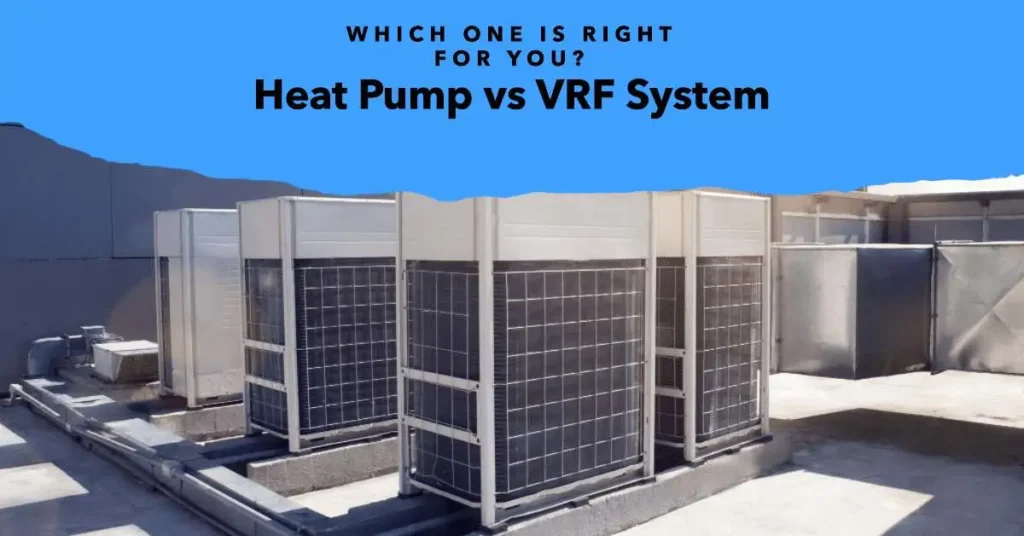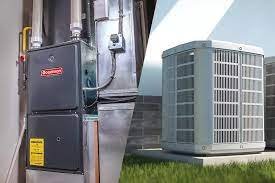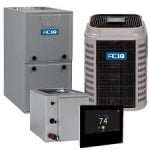Homeowners often seek energy-efficient and cost-effective solutions for their heating and cooling needs. Two popular options are heat pumps and Variable Refrigerant Flow (VRF) systems.
Heat Pumps: What You Need to Know
Heat pumps are HVAC systems that can both heat and cool a home. They work by transferring heat between the indoors and outdoors. In cold weather, they extract heat from the outside air or ground and bring it inside to warm your home.
In warm weather, the process is reversed, expelling heat from your home to cool it down. This versatility makes them an excellent choice for year-round climate control.
Pros:
- Energy Efficiency: Heat pumps are highly efficient, as they move heat rather than generate it, resulting in lower energy bills.
- Environmentally Friendly: They produce fewer greenhouse gas emissions compared to traditional heating systems.
- Versatility: They can both heat and cool, reducing the need for separate systems.
- Government Incentives: Many governments offer incentives for installing energy-efficient heat pumps.
Cons:
- Performance in Extreme Cold: Some heat pumps may struggle to provide sufficient heat in extremely cold climates.
- Upfront Costs: Initial installation costs can be higher than traditional systems.
- Maintenance: Heat pumps require regular maintenance to ensure optimal performance.
VRF Systems (Variable Refrigerant Flow):
How VRF Systems Work
Variable Refrigerant Flow (VRF) systems are advanced HVAC systems that use refrigerant to transfer heat. They can provide heating and cooling simultaneously to different zones within a building. VRF systems use a variable-speed compressor to precisely control the amount of refrigerant flow, adapting to the heating or cooling requirements of each zone.
Advantages
- Energy Efficiency: VRF systems are highly efficient and can save energy and money.
- Zoning Capability: They can heat and cool different areas independently, increasing comfort and efficiency.
- Space-saving: VRF systems require less space for ductwork, making them suitable for smaller homes.
- Quiet Operation: These systems are quieter compared to traditional HVAC systems.
Disadvantages
- Upfront Costs: Installation can be expensive, particularly for larger homes.
- Complexity: VRF systems are more complex to install and maintain, requiring professional expertise.
- Limited in Extreme Climates: They may not perform well in extremely cold or hot climates.
The Great HVAC Showdown: Heat Pump vs VRF

Heat Pump vs VRF: based on key factors such as energy efficiency, installation, maintenance, performance, and cost.
| Factor | Heat Pumps | VRF Systems |
|---|---|---|
| Energy Efficiency | – Highly efficient, with energy savings due to heat transfer. | – Highly efficient with precise control of refrigerant flow. |
| Installation | – Typically easier to install in most homes. | – Installation can be complex and may require professional expertise. |
| Maintenance | – Requires regular maintenance to ensure optimal performance. | – Maintenance is necessary but varies depending on the system’s complexity. |
| Performance | – Suitable for most climates, but may struggle in extremely cold areas. | – May not perform well in extreme climates. |
| Cost | – Initial costs can be higher but can result in long-term savings. | – Installation can be expensive, particularly for larger systems. |
Heat Pump vs VRF: Real-World Insights
Real-world experiences and case studies can provide valuable insights into the choices homeowners make regarding heat pumps and VRF systems:
Case Study 1: Heat Pump Success
In a residential area with a moderate climate, a homeowner opted for a heat pump system. This choice allowed them to efficiently heat their home during the winter and cool it in the summer, resulting in noticeable energy savings. The ease of installation and lower upfront costs were major factors in their decision.
Case Study 2: VRF Efficiency in Commercial Spaces
A commercial building decided to install a VRF system to provide heating and cooling to various zones. This allowed them to achieve precise temperature control in different areas while saving on energy costs. The simultaneous heating and cooling capability of VRF systems was a significant advantage in a space with diverse heating and cooling needs.
Heat Pump or VRF: Making Your Decision
When choosing between heat pumps and VRF systems, consider the following factors:
Climate
- Heat Pumps: Suitable for moderate climates. May struggle in extremely cold areas.
- VRF Systems: May not perform well in extreme climates.
Budget
- Heat Pumps: Typically have lower upfront costs.
- VRF Systems: Installation can be expensive, particularly for larger systems.
Energy Efficiency
Both systems offer high efficiency, but VRF systems provide precise control of refrigerant flow, enhancing efficiency.
Zoning Needs
- Heat Pumps: Offer single-zone heating and cooling.
- VRF Systems: Provide zoning capabilities, allowing different areas to be heated or cooled independently.
Maintenance
Both systems require regular maintenance to ensure optimal performance.
Space
VRF systems require less space for ductwork and are suitable for smaller homes and commercial buildings with space constraints.
Simultaneous Heating and Cooling
VRF systems excel in providing simultaneous heating and cooling, making them ideal for spaces with diverse needs.
Professional Installation
VRF systems may require professional expertise for installation due to their complexity.
Consider these factors based on your specific needs, climate, and budget to make an informed decision between heat pumps and VRF systems.
Remember that the choice between heat pumps and VRF systems should align with your unique requirements and the climate in which you live. Make an informed decision to ensure the most effective and efficient HVAC solution for your home or business.





